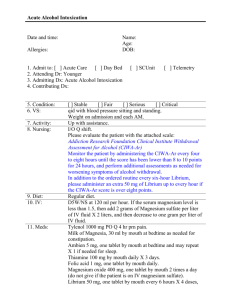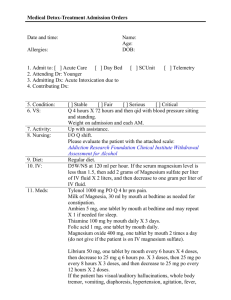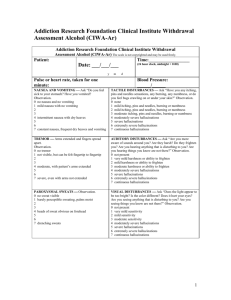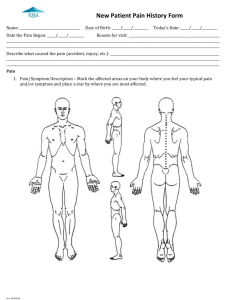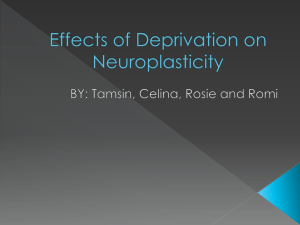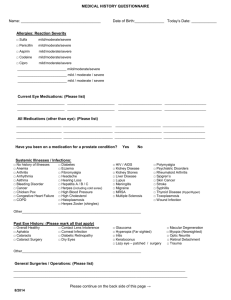Professional Guidance Place of Safety Document
advertisement
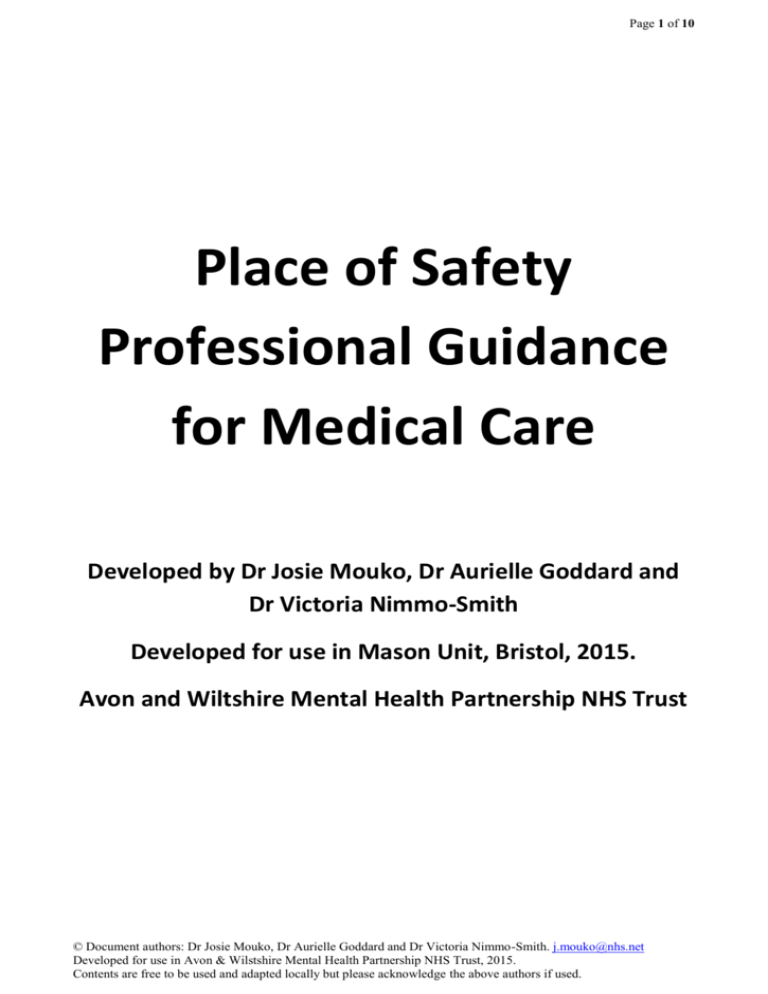
Page 1 of 10 Place of Safety Professional Guidance for Medical Care Developed by Dr Josie Mouko, Dr Aurielle Goddard and Dr Victoria Nimmo-Smith Developed for use in Mason Unit, Bristol, 2015. Avon and Wiltshire Mental Health Partnership NHS Trust © Document authors: Dr Josie Mouko, Dr Aurielle Goddard and Dr Victoria Nimmo-Smith. j.mouko@nhs.net Developed for use in Avon & Wilstshire Mental Health Partnership NHS Trust, 2015. Contents are free to be used and adapted locally but please acknowledge the above authors if used. Page 2 of 10 Disturbed Behaviour Flow Chart for Doctors in Place of Safety Detainee is admitted to Place of Safety Detainee displays behavioural disturbance. All staff to consider delirium/ low BM as possible cause. Nursing staff to request for MHA assessment to take priority No risk to self or others Risk to self or others. Consider Police assistance Doctors and Unit Staff: Please complete an incident form where any detainees have stayed on the unit beyond 3 hours for non-clinical reasons. This will highlight any system issues needing to be addressed. Non pharmalogical de-escalation techniques Non pharmacological de-escalation techniques to be employed. If failed, discuss with SHO on call who will need to assess. Psychiatric history of the detainee should be taken into consideration to guide around tolerance and appropriate level of treatment. Also consider agitated delirium. Where stat dose of lorazepam felt appropriate, assess capacity to consent. Capacitious and consenting Offer oral lorazepam where appropriate Whilst Detainee is on the Place of Safety they can only be treated against their will under the Mental Capacity Act. The Capacity Act only allows treatment to be administered in the patients ‘Best Interests’ Non capacitous. Clearly document capacity assessment. SHO to discuss with consultant on call. Capacitous and not consenting Medication cannot be given. Team to consider use of oral lorazepam under MCA if felt to best in best interests of patient (and least restrictive option). IM lorazepam is a last resort and should always be discussed with consultant. © Document authors: Dr Josie Mouko, Dr Aurielle Goddard and Dr Victoria Nimmo-Smith. j.mouko@nhs.net Developed for use in Avon & Wilstshire Mental Health Partnership NHS Trust, 2015. Contents are free to be used and adapted locally but please acknowledge the above authors if used. Page 3 of 10 Adult Physical Health & Medication Flow Chart for Doctors in Place of Safety Physical health (inc BM) assessed on admission by admitting nurse Admitting nurse to divert to ED if any concerns "red flags" (see local multiagency protocol) are identified Individuals should not be detained solely due to intoxication (inappropriate admissions should be flagged with manager of PoS) Under 18’s should be cared for by CAMHS service Possible Situations where Medical input may be needed. NB: Blind Prescribing is not acceptable. Detainee on essential regular medication and assessment/transfer not imminent Alcohol concerns: e.g. anticonvulsant, diabetic medications, clozapine, inhalers Doctor only to prescribe regular meds with collateral confirmation e.g. GP summary, patient records or "Connecting Care" which regular RMNs have access to. Other reasonable requests include paracetamol. Doctor to clarify current use and dependence. Known alcoholic? Current withdrawal symptoms? Known dependence and/or current withdrawal symptoms: Acute intoxication in nondependent Nurses to monitor for any signs of withdrawal Assess for high risk factors: (1) Previous seizure, (2) History of Wernicke’s or DTs. (3) Severe withdrawal symptoms (CIWAAr >15) Check BM >4. If BM low do not give anything sugary until Pabrinex given. Give IM Pabrinex (1 pair of ampoules OD for 3 days) for neuroprotection. Prescribe PRN Chlordiazepoxide for symptom triggered use with CIWA-Ar (see below) If high risk factors: low threshold for transfer to ED If Physical Health concerns develop whilst on the unit, for example, deteriorating NEWS score, self harming injuries, OD In emergency nursing staff to contact (9)999 And resus team on (2)222 if indicated If not emergency, contact Oakwood consultant/ SAS in hours or Psychiartry SHO out of hours (nights – senior SHO; twilight/weekend – Southmead A&E Psych SHO) Assessing doctor to perform appropriate assessment. To have a low threshold for discussion with A&E for advice or possible transfer. Doctor can contact out of hours GP service for advice © Document authors: Dr Josie Mouko, Dr Aurielle Goddard and Dr Victoria Nimmo-Smith. j.mouko@nhs.net Developed for use in Avon & Wilstshire Mental Health Partnership NHS Trust, 2015. Contents are free to be used and adapted locally but please acknowledge the above authors if used. Page 4 of 10 Supplementary information regarding Place of Safety: The Place of Safety (covering Bristol, Bath and North Somerset) is above Oakwood ward (called Mason Unit) on the Southmead site. What is Mason Unit? Places of safety are where police can bring patients who they have detained on a section136. The police have brought them there due to concerns about their mental health, and risk to self or others and they are awaiting formal MHA Assessment. They can be held there up to 72 hours, although they should be assessed within 2-3 hours, according to Royal College of Psychiatrists guidelines. Children or adults can be brought to PoS – care of under 18’s should be through CAMHS (contact via BRI switchboard 0117 923 0000). Point of contact for physical health concerns/ disturbed behaviour: The first point of contact should be the Oakwood consultant or SAS doctor in normal working hours (9-5 weekdays). In the evenings (5-9pm) and weekends /Bank holidays (9am-9pm), contact the Psychiatry SHO on call for Southmead A&E, via Southmead hospital switchboard on 0117 950 5050. Overnight (9.15pm9am), there is a Psychiatry “Senior SHO” covering the Bristol area, who can be contacted via the pager service on 07699 710 518. Doctors should have a low threshold for discussing any concerns with the on call psychiatry consultant (consultant responsible for patient according to home address), contactable via AWP switchboard 01225 325680 or NBT switchboard (0117 950 5050). Physical health advice can be obtained from Southmead A&E / med reg (NBT switch 0117 950 5050). Brisdoc (the out of hours GP service), have also stated that they are happy to provide advice &assistance as appropriate. A common sense approach should be taken, to ensure that these patients are not unfairly discriminated against just because they are in a place of safety, and that their physical and mental health is not neglected. The individual in the place of safety is not an inpatient, so does not need to be clerked, and you should only be involved to assist assess and manage according to the protocols above. Legal protections under MHA/ MCA: “Detaining a patient in a place of safety under sections 135 or 136 does not confer any power under the Act to treat them without their consent. In other words, they are in exactly the same position in respect of consent to treatment as patients who are not detained under the Act.” Mental Health Act 1983:Code of Practice (2015). The above code of practice applies to ALL patients in the Place of Safety, even when medical recommendations for admission are in place; therefore treatment (without consent) cannot be given under the MHA in any circumstance. Detainees are not considered an inpatient (and so cannot be treated without consent) until they reach the designated inpatient unit The only situation in which a detainee can be given medication in PoS is either when giving capacitous consent, or under the Mental Capacity Act. Common law can be used but MCA is preferable. Please note an important difference between the MHA and MCA is that patients may only be treated in their best interests under the MCA (not for the protection of others). If at all unclear, doctors to liaise with Consultant on call. No new antipsychotic or hypnotic medication should be given in the PoS, unless in exceptional circumstances, this is to ensure patient safety and to ensure true presentation is seen by assessors. Staff may consider if regular prescriptions will be of help to de-escalate situation, for example, if individual regularly takes benzodiazepines (must be verified with records). Staff may consider the use of seclusion as a 'last resort' to ensure everyone's safety. Doctor will need to regularly review if seclusion is implemented. Treatment cannot be started under a section 2 or 3 until the patient has been moved to the accepting unit, prior to that treatment can only be given either when a patient has capacitous consent, or under the Mental Capacity Act. © Document authors: Dr Josie Mouko, Dr Aurielle Goddard and Dr Victoria Nimmo-Smith. j.mouko@nhs.net Developed for use in Avon & Wilstshire Mental Health Partnership NHS Trust, 2015. Contents are free to be used and adapted locally but please acknowledge the above authors if used. Page 5 of 10 Delays in Mental Health Act Assessment, or of transfer out of Place of Safety: The Mental Health Act Code of Practice (revised April 2015) supports the RCPsych guidance that it is good practice for the doctor and AMHP to attend within 3 hours unless there are clinical grounds to delay it. If this is not occurring, then this should be documented and recorded. Therefore, please complete an incident form when patients have a stay in PoS longer than 3 hours unless on clinical grounds, stating this is a departure from the MHA Code of Practice." (see paragraph 16.47 of MHA code of Practice revised April 2015). Guidelines state that exceptions to this target should be based on clinical grounds (such as detainee being unfit for interview), rather than due to staffing (AMHP or S12 doctors) or bed availabilities (following recommendations for admission). This is from Royal College of Psychiatrists Guidelines (Statement PS2/2013, College Report CR159). The trust recognises that this 2-3 hour target is currently not being achieved for many patients, and so, along with other involved organisations, efforts are being made to remedy this, and it is expected that the duration of time detainees spend in Mason unit will decrease. Reasons for prolonged stays include delays in MHA assessments (on clinical or non-clinical grounds) or delays identifying a bed following medical recommendations for admission. Please complete an incident forms when detainees have stayed beyond 3 hours (for non-clinical reasons) on Mason Unit, to highlight on-going issues. Liaison with ED: The Emergency Department Consultant meets regularly with Place of Safety managers and is very supportive in ensuring equitable care for detainees in the Place of Safety, and support staff in having a low threshold for transfer to ED to manage complex physical health concerns. If doctors have any difficulties in discussion with ED staff, please raise this with Rachael Searle- Barnes, Ward Manager, who can feed this back to ED consultant. Remember to inform A&E staff that the POS is not an inpatient ward, but is merely a short term safe holding bay for detainees awaiting a MHA Assessment. Supervision Supervision is available for work on the Southmead site with the Psychiatry liaison consultant Dr Amy Green. Contact the working age liaison team at Southmead to contact Dr Green. In addition to this the consultant for the ward Dr Kolsut is happy to be contacted if trainees have any issues overnight they want to discuss the next working day directly. © Document authors: Dr Josie Mouko, Dr Aurielle Goddard and Dr Victoria Nimmo-Smith. j.mouko@nhs.net Developed for use in Avon & Wilstshire Mental Health Partnership NHS Trust, 2015. Contents are free to be used and adapted locally but please acknowledge the above authors if used. Page 6 of 10 Alcohol and the Place of Safety: The guidance below has been developed in liaison with BSDAS and aims to identify and manage those who are at risk of withdrawing from alcohol. The guidance is necessary as a contingency plan for those who have a prolonged stay in the PoS, to ensure their clinical safety. As always, any concerns should be discussed with ED department and/or seniors. This is different to the inpatient alcohol detoxification regime. Pabrinex should be given if high risk factors: http://www.avongpeducation.co.uk/handouts/2014/addiction/Pabrinex%20administration%202011.pdf Symptoms Poor diet Weight loss Cognitive impairment Vomiting Neurological symptoms No Green 0 Green 0 Green 0 Green 0 Green 0 Minor Green 0 Green 0 Amber 1 Amber 1 Amber 1 Severity Moderate Amber 1 Amber 1 Amber 1 Red 4 Red 4 Severe Red 4 Red 4 Red 4 Red 4 Red 4 Qualification of symptom severity Poor diet; moderate= 1 meal a day, severe= < 1 meal a day Weight loss; moderate = 1 stone in last 6 months, severe= > 1 stone in last 6 months Cognitive impairment; moderate= poor short-term memory and general forgetfulness Vomiting; moderate= > 3 times a week after food, severe= daily after food Neurological symptoms; moderate = transient pins and needles, severe= permanent pins and needles +/unsteadiness +/- reduced coordination Recommended treatment Green or 0: Oral thiamine (100mg bd) and vitamin B compound strong (1 tablet bd) Amber or 1- 3: IM Pabrinex one pair of ampoules od for three days Oral thiamine 100mg bd and vit B co st (1 tab bd) Red or 4 or more: IM Pabrinex one pair of ampoules od for three days minimum and Oral thiamine 100mg bd and vit B co st (1 tab bd) Those who are known to be dependent on alcohol, should always be prescribed PRN chlordiazepoxide, (even if currently intoxicated) to be administered in a symptom triggered way using CIWA-Ar. Those experiencing current withdrawal symptoms should be assumed to be dependent drinkers and treated in a similar way. Severity of symptoms can be assessed by nursing staff on an hourly basis using CIWA-Ar; when scoring <8 (mild) medication not currently required, reassess in an hour. Alcohol withdrawal can emerge quickly, so hourly nursing assessments are necessary for those identified as at risk. Scores of 8-15 (moderate) chlordiazepoxide should be given as below and the patient reassessed an hour later. If scoring >20 the patient is at high risk of seizures and requires ED transfer. If there are any signs of confusion, delirium, pyrexia or severe tremors, A&E is the safest place to manage the patient. Please see scoring CIWA-Ar assessment chart and assessment flow sheet below, and prescribe as follows. © Document authors: Dr Josie Mouko, Dr Aurielle Goddard and Dr Victoria Nimmo-Smith. j.mouko@nhs.net Developed for use in Avon & Wilstshire Mental Health Partnership NHS Trust, 2015. Contents are free to be used and adapted locally but please acknowledge the above authors if used. Page 7 of 10 Usual drinking units/day & relevant risk factors Chlordiazepoxide dose to prescribe PRN Max dose in 24 hours For use in people drinking <20 units daily and no other risks 20mg 120mg For those drinking >20 units/day and no other risk factors OR those drinking less but with known high risk factors 30mg 180mg For those drinking >20 units/day with known high risk factors OR those drinking >35 units/day and no other risk factors 40mg 200mg NB older adults may have delayed metabolism so consider lower dose schedule If someone is transferred from the place of safety to the ward then transfer them to the AWP inpatient detox charts as they are then likely to be in hospital for a longer period of time. Charts are found at: http://ourspace/ClientServices/DualDianosis/Documents/Procedure%20for%20the%20Assessment%20and%20Pharm acological%20Treatment%20of%20Alcohol%20Withdrawal%20on%20AWP%20Inpatient%20Facilities.docx Methadone/ Buprenorphine prescription. Alcohol withdrawal is life threatening, however, opiate withdrawal is not. Accidental or deliberate overdose of opiates is life threatening, therefore there are very few circumstances during which it would be appropriate for persons detained in PoS to be prescribed Methadone or buprenorphine. If people are prescribed opiates in the PoS, then discharged and resume normal replacement opiates, this could lead to death. If opiates are given in PoS, this should first be discussed with the patients community pharmacy in order to determine dosage and ensure that they are not dispensed a further dose at their community pharmacy on discharge to avoid overdose. Patients receiving daily supervised doses of opiate from Community Pharmacies have all day to “turn up” for their dose, so delays of a few hours do not matter. Please see below for “as required medication” if patients have distressing opioid withdrawal symptoms. Available stock medication in PoS - Benzodiazepines/ z drugs: Chlordiazepoxide, Diazepam, Lorazepam, Zopiclone, IM Lorazepam. Antipsychotics (only for those who use regularly) : oral Haloperidol, Risperidone & Olanzapine. Others: Pabrinex, Ibuprofen, Procyclidine, Promethazine, Paracetamol, Thiamine, Vit B costrong, Glycogel, GTN spray, NRT, Salbutamol inhalers, IM adrenaline. Patients own medication can be used in accordance to pharmacy guidelines. It may also be possible to obtain other regular medication from other inpatient units. The unit cannot administer depot medication or provide detainees with TTA’s on discharge. References: 1. Royal College of Psychiatrists: Position Statement PS2/2013,Guidance for commissioners: Service provision for Section 136 of the Mental Health Act 1983 (2011) guidance 2. Royal College of Psychiatrists (2011) Standards on the Use of Section 136 of the Mental Health Act 1983 (England and Wales) (College Report CR159). 3. Mental Health Act Code of Practice (see 16.17-16.76 for details of s136) https://www.gov.uk/government/uploads/system/uploads/attachment_data/file/396918/Code_of_Practice.pdf © Document authors: Dr Josie Mouko, Dr Aurielle Goddard and Dr Victoria Nimmo-Smith. j.mouko@nhs.net Developed for use in Avon & Wilstshire Mental Health Partnership NHS Trust, 2015. Contents are free to be used and adapted locally but please acknowledge the above authors if used. Page 8 of 10 Alcohol Withdrawal Assessment Scoring Guidelines (CIWA - Ar) Nausea/Vomiting - Rate on scale 0 - 7 0 – None 1 - Mild nausea with no vomiting 2 3 4 - Intermittent nausea 5 6 Tremors - have patient extend arms & spread fingers. Rate on scale 0 - 7. 0 - No tremor 1 - Not visible, but can be felt fingertip to fingertip 2 3 4 - Moderate, with patient’s arms extended 5 6 7 - Constant nausea and frequent dry heaves and vomiting 7 - severe, even w/ arms not extended Anxiety - Rate on scale 0 - 7 0 - no anxiety, patient at ease 1 - mildly anxious 2 3 4 - moderately anxious or guarded, so anxiety is inferred 5 6 7 - equivalent to acute panic states seen in severe delirium or acute schizophrenic reactions. Agitation - Rate on scale 0 - 7 0 - normal activity 1 - somewhat normal activity 2 3 4 - moderately fidgety and restless 5 6 7 - paces back and forth, or constantly thrashes about Paroxysmal Sweats - Rate on Scale 0 - 7. 0 - no sweats 1- barely perceptible sweating, palms moist 2 3 4 - beads of sweat obvious on forehead 5 6 7 - drenching sweats Orientation and clouding of sensorium - Ask, “What day is this? Where are you? Who am I?” Rate scale 0 - 4 0 - Oriented 1 – cannot do serial additions or is uncertain about date Tactile disturbances - Ask, “Have you experienced any itching, pins & needles sensation, burning or numbness, or a feeling of bugs crawling on or under your skin?” 0 – none 1 - very mild itching, pins & needles, burning, or numbness 2 - mild itching, pins & needles, burning, or numbness 3 - moderate itching, pins & needles, burning, or numbness 4 - moderate hallucinations 5 - severe hallucinations 6 - extremely severe hallucinations 7 - continuous hallucinations Auditory Disturbances - Ask, “Are you more aware of sounds around you? Are they harsh? Do they startle you? Do you hear anything that disturbs you or that you know isn’t there?” 0 - not present 1 - Very mild harshness or ability to startle 2 - mild harshness or ability to startle 3 - moderate harshness or ability to startle 4 - moderate hallucinations 5 - severe hallucinations 6 - extremely severe hallucinations 7 - continuous hallucinations 2 - disoriented to date by no more than 2 calendar days 3 - disoriented to date by more than 2 calendar days 4 - Disoriented to place and / or person Visual disturbances - Ask, “Does the light appear to be too Headache - Ask, “Does your head feel different than usual? bright? Is its color different than normal? Does it hurt your eyes? Does it feel like there is a band around your head?” Do not rate Are you seeing anything that disturbs you or that you know isn’t dizziness or lightheadedness. there?” 0 - not present 0 - not present 1 - very mild sensitivity 1 - very mild 2 - mild sensitivity 2 - mild 3 - moderate sensitivity 3 - moderate 4 - moderate hallucinations 4 - moderately severe 5 - severe hallucinations 5 - severe 6 - extremely severe hallucinations 6 - very severe 7 - continuous hallucinations 7 - extremely severe Assess and rate each of the 10 criteria of the CIWA scale. Each criterion is rated on a scale from 0 to 7, except for “Orientation and clouding of sensorium” which is rated on scale 0 to 4. Add up the scores for all ten criteria. This is the total CIWA-Ar score for the patient at that time. Prophylactic medication should be started for any patient with a total CIWA-Ar score of 8 or greater (ie. start on withdrawal medication), see protocol below for dosages. Document vitals and CIWA-Ar assessment on the Withdrawal Assessment Sheet. Document administration of PRN medications on the assessment sheet as well. The CIWA-Ar scale is the most sensitive tool for assessment of the patient experiencing alcohol withdrawal. Nursing assessment is vitally important. Early intervention for CIWA-Ar score of 8 or greater provides the best means to prevent the progression of withdrawal. Alcohol Withdrawal Assessment Flowsheet – Only for Use in Place of Safety. © Document authors: Dr Josie Mouko, Dr Aurielle Goddard and Dr Victoria Nimmo-Smith. j.mouko@nhs.net Developed for use in Avon & Wilstshire Mental Health Partnership NHS Trust, 2015. Contents are free to be used and adapted locally but please acknowledge the above authors if used. Page 9 of 10 Patient Name:……………….. DOB:………….. Date of assessment:…………. a. Vitals, Assessment Now. b. If initial score 8 repeat hourly for 8 hrs, then if stable 2hourly x 8 hrs, then if stable 4hourly. c. If initial score < 8, assess 4hourly. If score 8 at any time, go to (b) above. d. If indicated, (see indications below) administer prn medications as ordered and record on MAR and below. Date Time Pulse RR O2 sat BP Assess and rate each of the following (CIWA-Ar Scale): Refer to reverse for detailed instructions in use of the CIWA-Ar scale. Nausea/vomiting (0 - 7) 0 - none; 1 - mild nausea ,no vomiting; 4 - intermittent nausea; 7 - constant nausea , frequent dry heaves & vomiting. Tremors (0 - 7) 0 - no tremor; 1 - not visible but can be felt; 4 - moderate w/ arms extended; 7 - severe, even w/ arms not extended. Anxiety (0 - 7) 0 - none, at ease; 1 - mildly anxious; 4 - moderately anxious or guarded; 7 - equivalent to acute panic state Agitation (0 - 7) 0 - normal activity; 1 - somewhat normal activity; 4 - moderately fidgety/restless; 7 - paces or constantly thrashes about Paroxysmal Sweats (0 - 7) 0 - no sweats; 1 - barely perceptible sweating, palms moist; 4 - beads of sweat obvious on forehead; 7 - drenching sweat Orientation (0 - 4) 0 - oriented; 1 - uncertain about date; 2 - disoriented to date by no more than 2 days; 3 - disoriented to date by > 2 days; 4 - disoriented to place and / or person Tactile Disturbances (0 - 7) 0 - none; 1 - very mild itch, P&N, ,numbness; 2-mild itch, P&N, burning, numbness; 3 - moderate itch, P&N, burning ,numbness; 4 - moderate hallucinations; 5 - severe hallucinations; 6 – extremely severe hallucinations; 7 - continuous hallucinations Auditory Disturbances (0 - 7) 0 - not present; 1 - very mild harshness/ ability to startle; 2 - mild harshness, ability to startle; 3 - moderate harshness, ability to startle; 4 - moderate hallucinations; 5 severe hallucinations; 6 - extremely severe hallucinations; 7 - continuous.hallucinations Visual Disturbances (0 - 7) 0 - not present; 1 - very mild sensitivity; 2 - mild sensitivity; 3 moderate sensitivity; 4 - moderate hallucinations; 5 - severe hallucinations; 6 - extremely severe hallucinations; 7 continuous hallucinations Headache (0 - 7) 0 - not present; 1 - very mild; 2 - mild; 3 - moderate; 4 - moderately severe; 5 - severe; 6 - very severe; 7 - extremely severe Total CIWA-Ar score: PRN Med: Dose given (mg): Chlordiazpoxide Route: Time of PRN medication administration: Assessment of response (CIWA-Ar score 30-60 minutes after medication administered) RN Initials Scale for Scoring: Total Score = 0 – 9: absent or minimal withdrawal 10 – 19: mild to moderate withdrawal >20: severe withdrawal : High risk of seizures, requires ED transfer. Indications for PRN medication: Total CIWA-AR score 8 or higher (Symptom-triggered method). Please prescribe PRN chlordiazepoxide for all patients who have withdrawal signs/ symptoms. Also please prescribe for all dependent drinkers, even if currently showing no withdrawal signs. Nurses only need administer according to this protocol, but prescription should be available. Usual drinking units/day & relevant risk factors PRN Chlordiazepoxide dose to prescribe For use in people drinking <20 units daily and no other risks 20mg For those drinking >20 units/day and no other risk factors OR those drinking less but with 30mg known high risk factors For those drinking >20 units/day with known high risk factors with known high risk factors 40mg OR those drinking >35 units/day and no other risk factors NB older adults may have delayed metabolism so consider lower dose schedule Max dose in 24 hours 120mg 180mg 200mg © Document authors: Dr Josie Mouko, Dr Aurielle Goddard and Dr Victoria Nimmo-Smith. j.mouko@nhs.net Developed for use in Avon & Wilstshire Mental Health Partnership NHS Trust, 2015. Contents are free to be used and adapted locally but please acknowledge the above authors if used. Page 10 of 10
